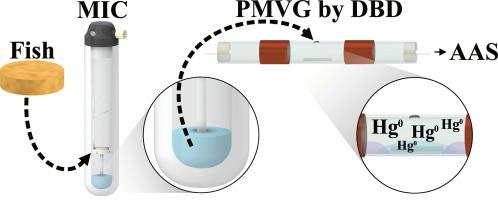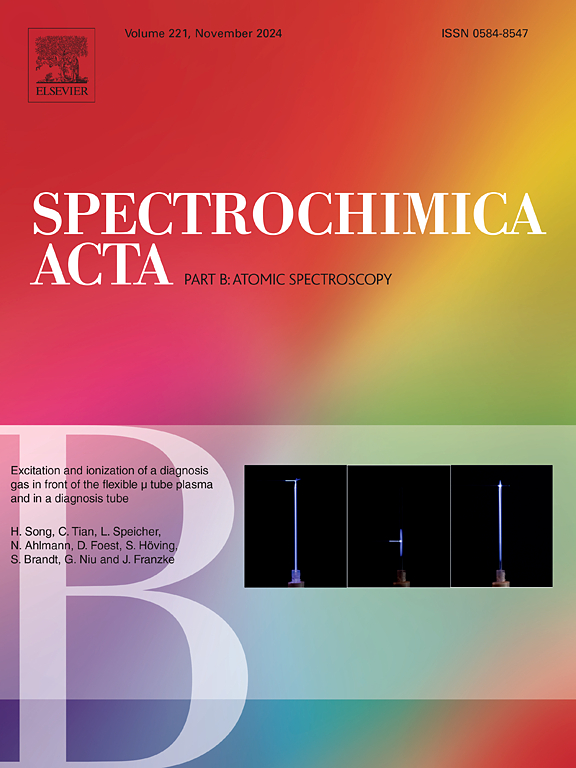微波诱导鱼组织燃烧后等离子体介导的汞蒸气生成及原子吸收光谱法检测
IF 3.2
2区 化学
Q1 SPECTROSCOPY
引用次数: 0
摘要
利用微波诱导燃烧(MIC)进行样品制备,并将管状介质阻挡放电(DBD)中的等离子体介导蒸汽发生(PMVG)作为样品引入系统,采用高分辨率连续光源原子吸收光谱法(HR-CS AAS)测定了鱼组织中的汞含量。主要目标是开发一种使用极少量试剂且几乎无干扰的汞测定方法。DBD 反应器中 PMVG 步骤的操作参数优化如下:放电气体为 70 mL min-1 Ar,电极距离为 20 mm,初级电压为 60 V,消化样品量为 50 μL(在 0.1 mol L-1 HNO3 基质中)。研究了 HNO3 浓度对 PMVG 效率的影响。当 HNO3 浓度达到 0.1 mol L-1 时,信号强度没有差异,而当酸浓度增加到 1 mol L-1 和 5 mol L-1 时,信号强度分别下降了 25% 和 40%。使用狗鱼肝脏(DOLT-4)的有证标准物质(CRM)以及在 MIC 前在样品上添加汞来评估所建议方法的准确性。在 MIC 中使用 500 毫克样品(或 250 毫克有证标准物质)和 6 毫升 0.5 摩尔/升-1 HNO3 作为吸收液,加标回收率和有证标准物质回收率分别为 104 % 和 97 %。检测限为 0.16 μg g-1 汞(绝对值为 160 皮克汞)。对 PMVG-AAS 和化学冷汽相电感耦合等离子体质谱法(CVG-ICP-MS)测定有证标准物质中汞的结果进行了比较,结果无明显差异。最后,一种高效、低成本、低试剂消耗量的样品引入系统成功地将 AAS 法测定汞与 MIC 法和随后的 DBD 法 PMVG 的优点结合在了一起。本文章由计算机程序翻译,如有差异,请以英文原文为准。

Plasma-mediated mercury vapor generation after microwave-induced combustion of fish tissue with detection by atomic absorption spectrometry
Mercury determination in fish tissues by high-resolution continuum source atomic absorption spectrometry (HR-CS AAS) was performed using microwave-induced combustion (MIC) for sample preparation, and plasma-mediated vapor generation (PMVG) in a tubular dielectric barrier discharge (DBD) as a sample introduction system. The main goal was to develop a method for Hg determination using very low amount of reagents being at the same time virtually free of interferences. The operational parameters of the PMVG step in the DBD reactor were optimized as follows: 70 mL min−1 Ar as the discharge gas, 20 mm electrode distance, primary voltage at 60 V and 50 μL as digested sample volume (in 0.1 mol L−1 HNO3 matrix). The effect of HNO3 concentration on the PMVG efficiency was studied. No differences in signal intensity were observed for HNO3 concentration up to 0.1 mol L−1, while a signal decrease by 25 % and 40 % was observed when the acid concentration increased to 1 and 5 mol L−1, respectively. Accuracy of the proposed method was evaluated using certified reference material (CRM) of dogfish liver (DOLT-4) and by Hg spikes on the sample prior to MIC. By using 500 mg of sample (or 250 mg of CRM) and 6 mL of 0.5 mol L−1 HNO3 as absorbing solution in MIC, recoveries of 104 % and 97 % were observed for spikes and CRM values, respectively. A limit of detection of 0.16 μg g−1 Hg (160 pg Hg absolute) was obtained. A comparison of the results for Hg determination in the CRM by PMVG-AAS and chemical cold vapor generation inductively coupled plasma mass spectrometry (CVG-ICP-MS) was performed with no significant differences in the results. Finally, an efficient, low-cost and low-volume reagent consumption sample introduction system for Hg determination by AAS was successfully combined with the advantages of MIC and subsequent PMVG by DBD.
求助全文
通过发布文献求助,成功后即可免费获取论文全文。
去求助
来源期刊
CiteScore
6.10
自引率
12.10%
发文量
173
审稿时长
81 days
期刊介绍:
Spectrochimica Acta Part B: Atomic Spectroscopy, is intended for the rapid publication of both original work and reviews in the following fields:
Atomic Emission (AES), Atomic Absorption (AAS) and Atomic Fluorescence (AFS) spectroscopy;
Mass Spectrometry (MS) for inorganic analysis covering Spark Source (SS-MS), Inductively Coupled Plasma (ICP-MS), Glow Discharge (GD-MS), and Secondary Ion Mass Spectrometry (SIMS).
Laser induced atomic spectroscopy for inorganic analysis, including non-linear optical laser spectroscopy, covering Laser Enhanced Ionization (LEI), Laser Induced Fluorescence (LIF), Resonance Ionization Spectroscopy (RIS) and Resonance Ionization Mass Spectrometry (RIMS); Laser Induced Breakdown Spectroscopy (LIBS); Cavity Ringdown Spectroscopy (CRDS), Laser Ablation Inductively Coupled Plasma Atomic Emission Spectroscopy (LA-ICP-AES) and Laser Ablation Inductively Coupled Plasma Mass Spectrometry (LA-ICP-MS).
X-ray spectrometry, X-ray Optics and Microanalysis, including X-ray fluorescence spectrometry (XRF) and related techniques, in particular Total-reflection X-ray Fluorescence Spectrometry (TXRF), and Synchrotron Radiation-excited Total reflection XRF (SR-TXRF).
Manuscripts dealing with (i) fundamentals, (ii) methodology development, (iii)instrumentation, and (iv) applications, can be submitted for publication.

 求助内容:
求助内容: 应助结果提醒方式:
应助结果提醒方式:


